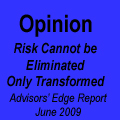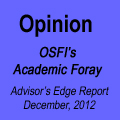BNS has released its 1Q09 Report to Shareholders and Supplementary Package, so it’s time to recalculate how much room they have to issue new preferred shares – assuming they want to!
Step One is to analyze their Tier 1 Capital, reproducing the prior format:
| BNS Capital Structure October, 2008 & January 2009 |
||
| 4Q08 | 1Q09 | |
| Total Tier 1 Capital | 23,263 | 22,839 |
| Common Shareholders’ Equity | 86.8% | 90.8% |
| Preferred Shares | 12.3% | 16.2% |
| Innovative Tier 1 Capital Instruments | 11.8% | 12.0% |
| Non-Controlling Interests in Subsidiaries | 2.2% | 2.4% |
| Goodwill | -9.8% | -12.3% |
| Miscellaneous | -3.3% | -9.1% |
| ‘Common Equity’ includes ‘Accumulated Foreign Currency Translation Losses’ and ‘Unrealized losses on AFS Equities’. | ||
| ‘Misc’ is ‘Other Capital Deductions’ | ||
Next, the issuance capacity (from Part 3 of the introductory series):
| BNS Tier 1 Issuance Capacity October 2008 & January 2009 |
|||
| 4Q08 | 1Q09 | ||
| Equity Capital | (A) | 17,653 | 16,379 |
| Non-Equity Tier 1 Limit | B=0.666*A | 11,757 | 10,908 |
| Innovative Tier 1 Capital | (C) | 2,750 | 2,750 |
| Preferred Limit | (D=B-C) | 9,007 | 8,158 |
| Preferred Actual | (E) | 2,860 | 3,710 |
| New Issuance Capacity | (F=D-E) | 6,147 | 4,448 |
| Items A, C & E are taken from the table “Regulatory Capital” of the supplementary information; Note that Item A includes Goodwill, FX losses, “Other Capital Deductions” and ‘non-controlling interest’ and ‘Other Deduction’; it is equal to Net Tier 1 Capital less preferred shares and Innovative Capital Instruments Item B is as per OSFI Guidelines; the limit was recently increased. Items D & F are my calculations |
|||
It is noteworthy that the increases in Goodwill (about $550-million) and Other Capital Deductions (about $1,500-million) have been met largely through the issuance of Preferred Shares. Scotia’s note on Other Capital Deductions states:
Comprised of net after-tax gains on sale of securitized assets, and 50% of all investments in certain specified corporations, and other items.
TD was also affected by the rule change, which requires a 50/50 deduction from Tier 1 and Tier 2 instead of the old 0/100 split. Additionally, Scotia’s purchase of CI Investments closed and this will have affected Goodwill as well.
and the all important Risk-Weighted Asset Ratios!
| BNS Risk-Weighted Asset Ratios October 2008 & January 2009 |
|||
| Note | 4Q08 | 1Q09 | |
| Equity Capital | A | 17,653 | 16,379 |
| Risk-Weighted Assets | B | 250,600 | 239,700 |
| Equity/RWA | C=A/B | 7.04% | 6.83% |
| Tier 1 Ratio | D | 9.3% | 9.5% |
| Capital Ratio | E | 11.1% | 11.4% |
| Assets to Capital Multiple | F | 18.23x | 18.62x |
| A is taken from the table “Issuance Capacity”, above B, D & E are taken from BNS’s Supplementary Report C is my calculation. F is my estimate from the 4Q08 review (OSFI has not yet seen fit to publish the numbers) and BNS’s Supplementary Report (1Q09) of total assets ($509.8-billion) divided by total capital ($27.378-billion) (see below) |
|||
Scotia reports a “Tangible Common Equity” Ratio of 7.8%; I suspect that this is the same as my “Equity / RWA” ratio without accounting for the Miscellaneous Deductions. As I stated when reviewing TD, I am comfortable with my figure; in times of stress the bank might find it difficult to remove or realize capital from non-consolidated subsidiaries.
The bank does not disclose its 1Q09 Assets-to-Capital multiple, stating only:
OSFI has also prescribed an asset-tocapital leverage multiple; the Bank was in compliance with this threshold as at January 31, 2009.
Scotia as $43,526-million exposure to derivatives on the balance sheet; but notes on page 30 of the supplementary report that the effect of Master Netting Agreements and Collateral is to reduce this to $16,757-million – an entirely manageable amount.









































































































